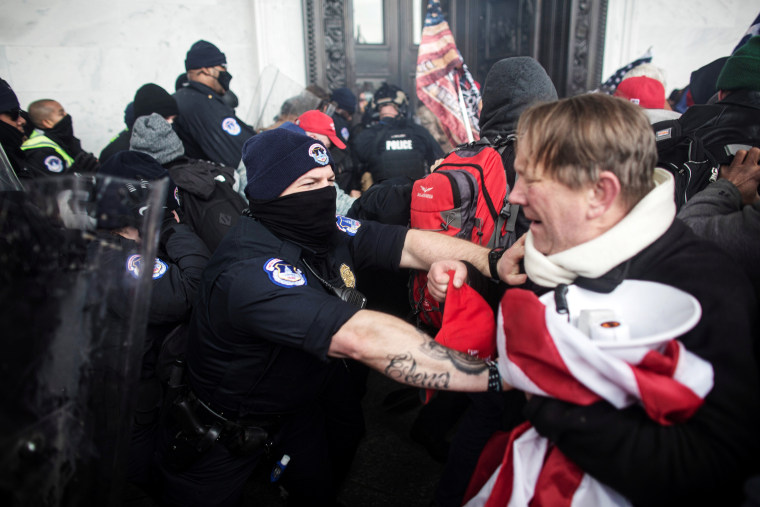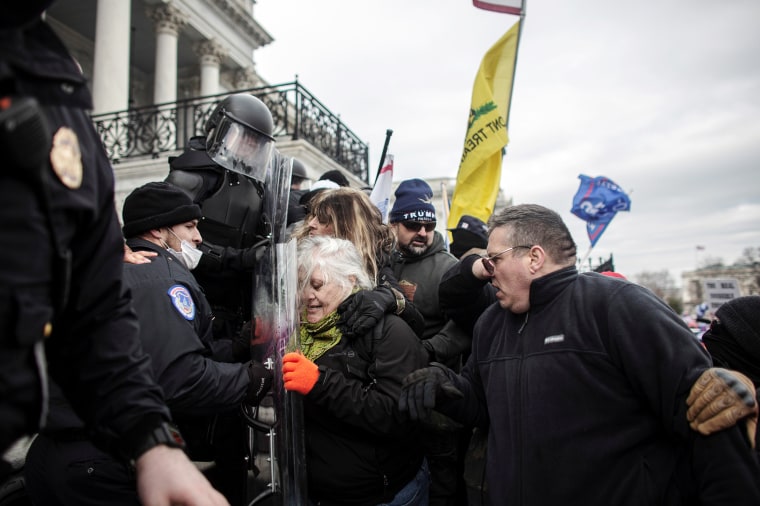WASHINGTON — Amid growing evidence that pro-Trump extremists were planning to target the U.S. Capitol on Jan. 6, the day Congress was set to certify the election of Joe Biden as president, in recent days Congressman Tim Ryan had asked the people in charge of security whether they had everything they needed.
"I had conversations with the sergeant-at-arms and the chief of the Capitol Police, who gave me assurances that every precaution was being taken, that we had enough manpower, that we were going to keep people completely away from the Capitol," Ryan, the Ohio Democrat who chairs the subcommittee that funds the Capitol complex, told reporters Thursday.
What happened instead was a security failure that one federal law enforcement official described “as the darkest day since 9/11," and Ryan and other members of Congress are now seeking answers.
Not all of the facts are in, but some are clear. Defense Department officials said Thursday that during planning meetings prior to Jan. 6 led by the Justice Department, city officials and federal law enforcement agencies requested only modest support from the National Guard and did not anticipate large-scale violence. The Pentagon agreed to provide 300 unarmed troops, mostly to help oversee traffic checkpoints and Metro subway stations.
The Pentagon officials said that on Sunday, during a planning meeting, the Defense Department offered the Capitol Police and the city of Washington additional National Guard troops, but were turned down.
Said Pentagon spokesman Jonathan Hoffman, “We were informed that additional support from DoD was not needed.”
Kenneth Rapuano, assistant secretary of defense for homeland defense and global security, said that during the meetings, law enforcement provided “general descriptions of some internet traffic” from groups who planned to support the Trump rally on Jan. 6, “but overall the assessment we got repeatedly was there was no indication of significant violent protests."
NBC News has previously reported that online forums popular with far-right activists were filled with threats and expectations of violence in the days leading up to Jan. 6.
On Jan. 6, the Capitol Police, the 2,000-person force whose job is to secure the legislative complex, failed to deploy enough officers to protect the Capitol from rioters, and put them out in regular uniforms instead of riot gear.

Those officers were no match for a determined group of rioters, some of whom bashed the police in the head with lead pipes and doused them with pepper spray, Ryan said.
"Make no mistake, these were violent people," Ryan said.
Meanwhile, whatever plan the Capitol Police had to request reinforcements didn't work. More than an hour elapsed from the time rioters approached the Capitol building to the time they began smashing their way inside through a window, Ryan said, but no help materialized. Rioters entered through the window at about 2 p.m.
Federal law enforcement officials in Washington said they watched with growing alarm as television images showed the rioters rampaging through the Capitol.
A Justice Department official said that the bulk of deployable agents from the DoJ and the Department of Homeland Security, usually held in reserve in advance of potentially violent events, were not called upon until after the protesters had breached the building.
Because the Capitol Police have first jurisdiction over protecting the Capitol building and members of Congress, federal agencies could only be involved at their discretion.
"We watched in horror," the official said. "As much as we wanted to be there, we couldn't send anyone in without the specific request of the Capitol Police. This is their area first."
In the hours after the breach, agents from the Federal Protective Service, Customs and Border Protection, the Bureau of Prisons, the FBI and Alcohol Tobacco and Firearms — some heavily armed, in tactical gear — were called in to assist Capitol Police and D.C.'s Metropolitan Police Department.
From DHS, some Secret Service agents were deployed, but agents from Customs and Border Protection, who responded to protests in D.C. this summer, were not called upon until much later.
A senior law enforcement official said that the DOJ offered federal law enforcement help to the Capitol Police on Wednesday as the situation deteriorated, but said the Capitol force was slow to accept the offer.
In preparation for the Jan. 6 demonstration, the Department of Homeland Security began a "virtual situation room." A DHS spokesman said the set up was "to facilitate department and interagency communication and coordination as we do for many large events in D.C."
Spokespeople for the Justice Department and the Department of Homeland Security declined to say what intelligence they had gathered before the event that may have indicated it would end with violence and a massive breach of the Capitol complex. Social media posts by extremists in the days prior to Jan. 6 had made the risk of confrontation clear.
Rep. Ryan told reporters on Thursday that as many as 60 Capitol Police officers were injured, including 15 who were hospitalized and one in critical condition, following Wednesday's violent clashes.
On Wednesday, D.C. Mayor Muriel Bowser had said in a letter to Defense and Justice officials that the city was "not requesting other federal law enforcement personnel" in addition to Secret Service, Capitol Police and Park Police.
"We are mindful that in 2020, MPD was expected to perform the demanding task of policing large crowds while working around unidentifiable personnel deployed in District of Columbia without proper coordination," Bowser said in a letter to the Pentagon and Justice Department.
Officials were also cognizant of the heavy-handed tactics the Trump administration used against Black Lives Matter protesters in the wake of the death of George Floyd.
But a former DHS official who declined to be named said that a reserve force should have been staged out of sight, to be able to respond if the situation spiraled out of the police's control.
Once the rioters moved on the building, "They should have had a very visible presence, with cops in riot gear," the official said. "You use overwhelming force. You declare it an unlawful assembly. And you immediately begin implementing crowd control techniques. They didn't do any of that. They did nothing."
Capitol Police shot and killed one rioter, identified as Air Force veteran Ashli Babbitt of San Diego, as protesters were forcing their way toward the House Chamber where Members of Congress were sheltering in place.

Ryan said he was told that "no one was going to be anywhere close to the Capitol. The next thing you know you turn on the tv and they're swinging from the Capitol building with flags."
"The rank and file did everything they could," he said, but "for us not to have an expeditious plan" to provide reinforcements amounted to "an epic fail."
"That was a strategic blunder and it put a lot of lives in danger," he said. "We're going to dig deep and find out exactly what happened."
He added that there was an "intelligence failure" to anticipate the scope of the threat.
While praising the heroics of most rank and file Capitol Police, he said he was concerned about videos showing police officers appearing to act with passivity, and in one case posing for a selfie with a rioter.
The fallout was swift.
Senate Democratic Leader Chuck Schumer, D-N.Y., said he would fire the Senate's Sergeant-at-Arms Mike Stenger when Democrats assume power later this month. Late Thursday, current Majority Leader Sen. Mitch McConnell, R-Ky., said he had asked for and received Stenger's resignation. Speaker Nancy Pelosi, D-Calif. said House Sergeant-at-Arms Paul Irving would be resigning, and she also called for the resignation of Capitol Police Chief Steven Sund, saying she had not heard from him since the building was breached.
Download the NBC News app for breaking news and politics
Chief Sund said in a statement on Thursday that his officers "responded valiantly when faced with thousands of individuals involved in violent riotous actions as they stormed the United States Capitol Building," but he didn't address the criticism. Later on Thursday, he announced he would resign his post effective Jan. 16.
Said Ryan, "The big question is with regard to backup and manpower and why wasn't that ready with a phone call being placed, hey we need more, and more show up. …When you get assurances that things are supposed to go a certain way and they don't, that is very frustrating."
Ryan also wondered whether the Capitol Police were instructed to avoid confrontation.
Capitol Police were so overwhelmed they didn't appear to arrest any of the rioters. But by Thursday afternoon, the acting D.C. U.S. Attorney, Mike Sherwin, said his office had charged 55 suspects with various offenses, including unlawful entry, assault, theft and weapons charges.
"We're never going to look at the Capitol the same way," Ryan said. "This was basically domestic terrorism at one of the great shrines of our democracy."
The Capitol Police and Mayor Bowser's office did not immediately respond to requests for comment.





